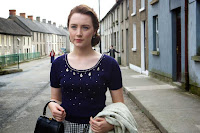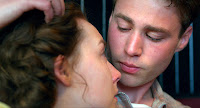Brooklyn, adapted by Nick Hornby from Colm Tóibín’s 2009 novel and directed by John Crowley may be the best romantic drama of the past three or four years. There were times when I found myself holding my breath and wishing it would not end and then that it would end in a very specific way. Neil heard the tears from other audience members at the end and, as we stood reading the credits, I had a strong urge to sit down and watch it all over again. Yes, it’s that good. In fact, to quote Mary Poppins, it’s practically perfect in every way.
 |
| At Coney Island |
It’s rare that working class characters are the focus of a major movie, though they regularly featured in New York set movies of the ‘30s through the ‘60s. In many ways, this looks like a movie made in that period except in color. That coloring has a legendary quality at times – maybe because some images such as the Manhattan skyline were CGI – but it works in its favor. There’s a beautiful sequence on Coney Island where a bathing suit (and especially the different manners in which Americans and Europeans layer clothes) and a pair of men’s long pants capture the mood of a decade and the aspirations of a generation. The rolling fortunes of different ethnic groups – Irish, Italian, and Black are mentioned both in the dialogue and visually; the upward mobility of women; and the migration from the past rural (Ireland) to the present urban (NYC) to the dreamed of future suburbs (Long Island) enrich a potentially simple fable into the profundity of myth.
 |
| Saoirse Ronan in Ireland |
This could be a family creation story told through the generations, but it’s also an adventure story featuring a female protagonist (you’d guess rightly that it wasn’t made or financed by Americans. Instead, Ireland, the U.K., and Canada made it happen). A young Irish girl leaves home, sponsored by her older sister and a priest, to pursue greater possibilities in New York in 1951. She experiences intense homesickness even as various people reach out to her. She finds fortune in kindness and help by her landlady, her supervisor, and her parish priest in Brooklyn
 |
| Julie Walters as the Landlady |
and that generosity by an older generation to ease the way for a younger adult reminded me of Vincente Minnelli’s The Clock (1945), also set in a similar era. She returns these kindnesses with gratitude, respect, and good humor. She goes to a church dance and she sees a young man looking at her and in that moment, most viewers will know and begin to hope. I won’t say anything more because the magic of this movie is in how it looks at the most mundane details of everyday life with a sense of wonder.
 |
| An Individual Young Woman |
Saoirse Ronan in the lead has the open face and graceful body in which a viewer can read pure and complex emotions. She doesn’t need dialogue to express the character, which puts her in a league with Lillian Gish, Anna Magnani, Sophia Loren, Gong Li, and Julianne Moore. She was perverse and sort of frightening in Atonement (2007) when she was thirteen, but she presents the soul of the immigrant experience here. My Mother thought she was beautiful. She is, but it’s because she embodies a character that grows emotionally, intellectually, and even physically before our eyes. She could be almost any young girl at the beginning, but at the end she is that individual young woman and the light that shines on her in the final frames could be a halo.
 |
| Emory Cohen with Saoirse Ronan |
Emory Cohen carries himself and reproduces the accent of a guy from ‘50s Brooklyn who would have been a featured movie player, but his eyes and facial contours might have entranced Caravaggio. He has the uncanny ability of making the camera love him from the first shot in which he appears. Burt Reynolds would instruct the camera to love him daily during a shoot and no performer can be a true star without that connection. He’s unrecognizable from when he was the teenage son confused by his parents’ split up on TV’s Smash. His keen vulnerability seemed like a real teenager’s, which made him an anomaly on a show that was almost completely artificial about artifice.
 |
| Ronan and Cohen |
Domhnall Gleeson, Julie Walters, Jim Broadbent, and Jessica Paré give performances detailed enough that viewers might want to know more about what’s going on in their characters’ lives beyond what is shared in the plot. Irish stage actress Brid Brennan stuns as a figure out of a fairytale, a witch who wakes the young heroine. The lighting, props, and furniture in this scene feel as creepy as Jabba the Hutt’s surroundings and it’s a credit to Crowley’s tonal control that it works perfectly to initiate the plot’s climax without upending the naturalism of the story. Another instance of a movie working on all levels is when two inexperienced people decide to make love for the first time and it doesn’t quite work right, but the camera captures one of the character’s faces and the look says, “oh, I thought it would be something more, but it’ll get better because I love this person.” It’s pretty incredible when a performer and a cinematographer (in this case, Yves Bélanger) can capture something so poignant and true.



















